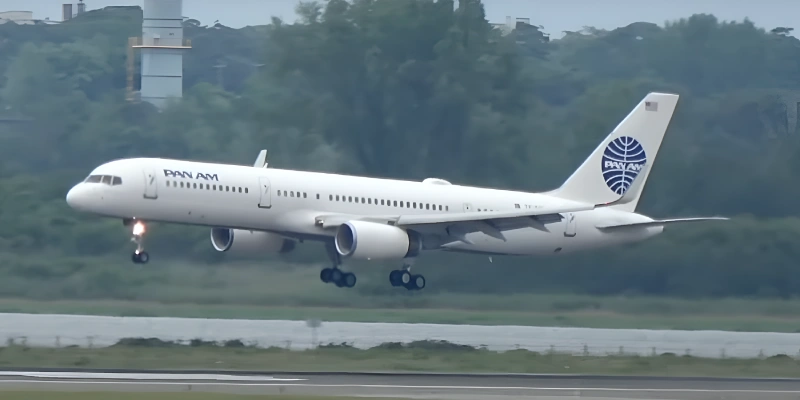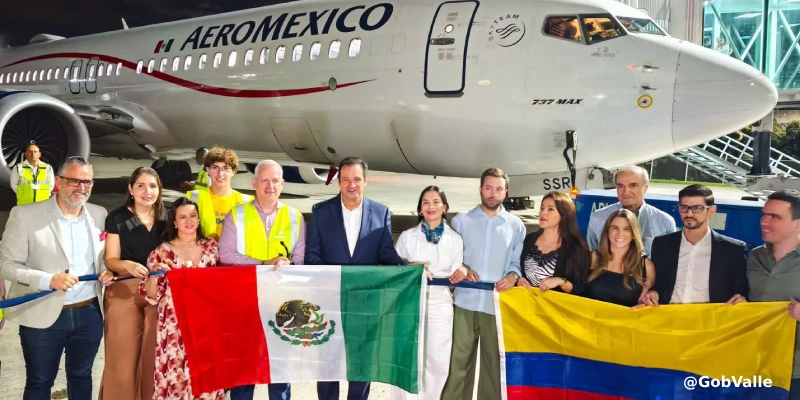Pan American World Airways, the legendary airline that revolutionized air travel in the 20th century, is back. This time, however, it has returned in a very different guise: as a luxury experience for a select clientele, closer to cinema and nostalgia than to commercial transportation.
This month, a group of former Pan Am flight attendants gathered nostalgically at Terminal 7 of New York’s JFK Airport. With tears in their eyes, they watched a customized Boeing 757 bearing the airline’s famous blue logo touch down. This was no ordinary flight: it marked the beginning of a private 12-day transatlantic journey, with stops in Bermuda, Lisbon, Marseille, London, and Shannon before returning to New York.
A Journey to the Golden Era
The aircraft, with a capacity for just 50 passengers, offers a premium experience: fully reclining seats, personal entertainment devices, an open bar, gourmet meals, and a crew dressed in faithful replicas of Pan Am uniforms—complete with white gloves and hats. The cost? $59,950 per person based on double occupancy; solo travelers pay an additional $5,600.

While this isn’t the first time the Pan Am logo has graced the skies since the airline’s closure in 1991, it does mark the beginning of a new chapter. In February 2024, the brand was acquired by Craig Carter, a former executive in luxury travel companies, along with four other investors from the hospitality and event marketing sectors.
A Legendary Brand with a Modern Strategy
What Carter and his team purchased was more than a license—it was a symbol. Pan Am’s legacy already lived on in Breitling and Timex watches, alcoholic beverages, clothing, and other products. But their vision was clear: to bring the Pan Am experience back to the skies.
→ Delta Inaugurates New Nonstop Route Between Salt Lake City and Seoul
This exclusive journey was organized by Bartelings, experts in private jet tours, and Criterion Travel, specialists in high-end cultural travel. The itinerary revives the original destinations of Pan Am’s first transatlantic routes, active since 1939. Travelers stay in luxury hotels such as the Fairmont Hamilton Princess in Bermuda, the Four Seasons in Lisbon, and the historic Savoy in London. In Shannon, Ireland, the stop includes a visit to the Foynes Flying Boat Museum, featuring a full-scale replica of the famous Boeing 314 “Yankee Clipper.”
A Sensory Experience Steeped in Nostalgia
For those on board, the journey is a leap back in time. The cabin crew—on loan from Icelandair—captures the classic aesthetic of aviation’s golden age. At the terminal, the group drew stares as if they were movie stars, a stark contrast to modern travelers in athleisure and airport slippers.
Inside the 757, passengers enjoy modern comforts with a retro twist. While chateaubriand is no longer served in the aisle, champagne flows freely. No leg of the trip exceeds seven hours, but the seats allow for fully reclined sleep. The lavatory, though not period-accurate, features upgraded finishes.
The response has been overwhelming: the flight sold out effortlessly. Many passengers have personal ties to Pan Am. Debbi Fuller, a flight attendant from 1980 to 1989, was among them. Her 83-year-old husband, upon seeing the brochure’s price, told her, “I won’t take this with me. I know how much Pan Am meant to you. And I lost that much in the stock market last week.” Fuller wore her vintage uniform, with minor adjustments, and planned to showcase it in Bermuda.
Pan Am Community: A Legacy That Still Soars
Pan Am isn’t just history—it’s a living community. The Pan Am Museum Foundation raises funds to preserve its legacy, including a museum, a podcast, and a YouTube channel. The network of former employees remains tight-knit. Wendy Knecht, a former flight attendant and now a foundation contributor, joined the first leg of the trip. “Even though we haven’t worked together in over 30 years, we feel like family,” she says.
But Carter isn’t banking solely on nostalgia. He believes Pan Am’s glamour holds appeal beyond former employees. The market seems to agree: similar experiences, like the TWA Hotel at JFK, have proven there’s demand for high-end retro travel. In Europe and Asia, luxury trains inspired by bygone eras sell for tens of thousands of dollars.
What’s Next: More Destinations, More Pan Am
A second trip is already planned for next April: a 21-day transpacific journey with stops in Tokyo, Siem Reap (Cambodia), Singapore, Darwin and Sydney (Australia), Auckland, and Nadi (Fiji). Price: $94,495 per person based on double occupancy; solo travelers pay an extra $9,500.
For those who can’t afford such luxury, Pan Am has more options on the horizon: a themed hotel in Los Angeles and a ground-based experience styled as a “dinner and a show” inside a stationary aircraft decorated in 1970s fashion. However, the airline’s famous bags won’t be available to the general public—though they’re still sold in 14 stores in South Korea.
Will Pan Am Return as a Real Airline?
The most ambitious dream is also the most complex: resuming regular flight operations. The team has already begun the process with the FAA and, as a symbolic first step, reclaimed the historic call sign: Clipper.
Pan Am, at least in spirit, never left. But now, with renewed wings, it takes off once more—not just to conquer the skies, but also the memories and hearts of travelers.
With information from Bloomberg
Related Topics
Arajet Announces Direct Flights Between Punta Cana and Córdoba, Argentina
Porter Airlines Announces Flights to Mexico, the Caribbean, and Costa Rica from Canada for Winter
LATAM Launches Two New Routes Between Brazil and Argentina
Aeroméxico Resumes Direct Route Between Mexico City and Cali, Colombia

Plataforma Informativa de Aviación Comercial con 13 años de trayectoria.




